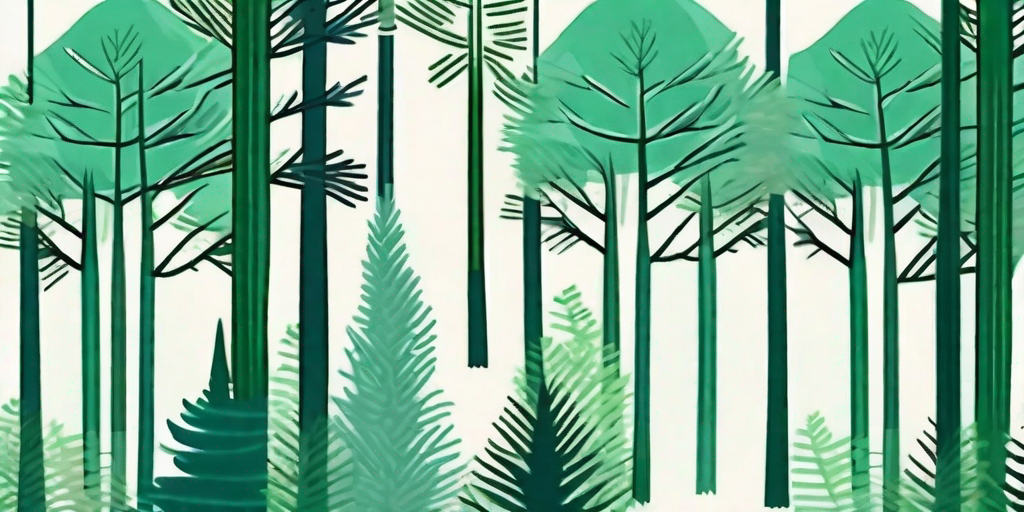
Welcome to the fascinating world of softwood trees, where we'll embark on a journey from the humble pine to the majestic cedar. These trees are not only a feast for the eyes but also play a crucial role in our daily lives. So, buckle up and get ready for an adventure of a lifetime!
Understanding Softwood Trees
First things first, let's get our facts straight. Softwood trees, contrary to their name, are not necessarily soft. They're named so because they belong to the gymnosperm family, which in Greek means 'naked seeds'. Now, don't get any cheeky ideas, it's just botany!
These trees are coniferous, meaning they bear cones and have needle-like leaves. They grow faster than their hardwood counterparts and are, therefore, more affordable. So, next time you're shopping for furniture, you know where your budget-friendly options come from.
The Pine Tree: The Underdog of Softwoods
Let's start our journey with the pine tree, the underdog of softwoods. It's everywhere, from your furniture to your Christmas decorations. But, do we really know it? Pine trees are known for their resilience and can grow in a variety of climates, from the cold mountains to the hot tropics. Talk about versatility!
There are over 100 species of pine trees, each with its unique characteristics. The most common ones include the white pine, known for its light weight and straight grain, and the yellow pine, famous for its strength and density. So, next time you see a pine tree, give it a nod of respect for its diversity.
The Cedar Tree: The Royalty of Softwoods
Now, let's move on to the cedar tree, the royalty of softwoods. Cedar trees are known for their aromatic wood, which not only smells heavenly but also repels insects. So, if you're tired of those pesky bugs, you know what to plant in your backyard.
Cedar wood is also resistant to decay and moisture, making it a popular choice for outdoor furniture and fencing. So, while the cedar tree might not be as ubiquitous as the pine, it certainly holds its own in the softwood kingdom.
The Uses of Softwood Trees
Now that we've met our main characters, let's delve into the many uses of softwood trees. These trees are like the Swiss army knives of the plant kingdom, serving multiple purposes.
Softwood trees are primarily used for timber and paper production, thanks to their fast growth and abundant supply. They're also used for making furniture, flooring, and even musical instruments. So, the next time you're strumming your guitar, remember to thank a softwood tree.
Softwood in Construction
Softwood trees play a crucial role in the construction industry. Their wood is used for framing houses and building decks, thanks to its strength and durability. So, if you're living in a wooden house, chances are, you're living in a softwood tree.
Softwood lumber is also used for making doors, windows, and cabinets. It's easy to work with and can be shaped into intricate designs. So, the next time you admire a beautifully carved door, remember the humble softwood tree.
Softwood in Paper Production
Softwood trees are also the unsung heroes of the paper industry. Their long fibers make strong and durable paper, perfect for your books and newspapers. So, the next time you're engrossed in a gripping novel, spare a thought for the softwood tree.
Softwood pulp is also used for making tissues, toilet paper, and paper towels. So, from your morning newspaper to your bedtime book, the softwood tree is with you throughout your day.
FAQs about Softwood Trees
Are all softwood trees evergreen?
Most softwood trees are evergreen, meaning they retain their leaves throughout the year. However, there are a few exceptions like the larch and the bald cypress, which shed their leaves in autumn. So, while most softwood trees are ready for Christmas all year round, a few like to change their outfits with the seasons.
Are softwood trees good for the environment?
Yes, softwood trees are great for the environment. They absorb carbon dioxide and release oxygen, helping to combat climate change. They also provide habitat for wildlife and prevent soil erosion. So, planting a softwood tree is like giving a gift to Mother Nature.
Can softwood trees be used for firewood?
Yes, softwood trees can be used for firewood. However, they burn faster and produce less heat than hardwoods. They're perfect for a quick, crackling fire, but if you're planning a long, cozy evening by the fireplace, you might want to stock up on hardwoods.
Conclusion
So, there you have it, a whirlwind tour of the world of softwood trees. From the versatile pine to the aromatic cedar, these trees are an integral part of our lives. They provide us with shelter, warmth, and even entertainment. So, let's take a moment to appreciate these unsung heroes of the plant kingdom.
Remember, every tree has a story to tell, and every story is worth listening to. So, the next time you come across a softwood tree, take a moment to listen to its tale. You might be surprised at what you learn.















